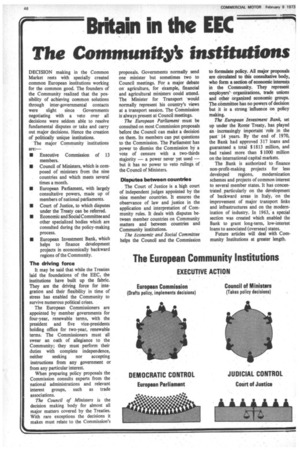Britain in the EEC
Page 48

If you've noticed an error in this article please click here to report it so we can fix it.
The Community's institutions
DECISION making in the Common Market rests with specially created common European institutions working for the common good. The founders of the Community realized that the possibility of achieving common solutions through inter-governmental contacts were slight since Governments negotiating with a veto over all decisions were seldom able to resolve fundamental disputes or take and carry out major decisions. Hence the creation of politically unique institutions.
The major Community institutions are:— • Executive Commission of 13 members.
• Council of Ministers, which is composed of ministers from the nine countries and which meets several times a month.
• European Parliament, with largely consultative powers, made up of members of national parliaments.
• Court of Justice, to which disputes under the Treaty can be referred.
• Economic and Social Committee and other specialized bodies which are consulted during the policy-making process.
• European Investment Bank, which helps to finance development projects in economically backward regions of the Community.
The driving force It may be said that while the Treaties laid the foundations of the EEC, the institutions have built up the fabric. They are the driving force for integration and their flexibility in time of stress has enabled the Community to survive numerous political crises.
The European Commissioners are appointed by member governments for four-year, renewable terms, with the president and five vice-presidents holding office for two-year, renewable terms. The Commissioners must all swear an oath of allegiance to the Community; they must perform their duties with complete independence, neither seeking nor accepting instructions from any government or from any particular interest.
When preparing policy proposals the Commission consults experts from the national administrations and relevant interest groups, such as trade associations.
The Council of Ministers is the decision making body for almost all major matters covered by the Treaties.
(With rare exceptions the decisions it makes must relate to the Commission's
proposals. Governments normally send one minister but sometimes two to Council meetings. For a major debate on agriculture, for example, financial and agricultural ministers could attend. The Minister for Transport would normally represent his country's views at a transport session. The Commission is always present at Council meetings.
The European Parliament must be consulted on most Commission proposals before the Council can make a decision on them. Its members can put questions to the Commission. The Parliament has power to dismiss the Commission by a vote of censure with a two-thirds majority — a power never yet used — but it has no power to veto rulings of the Council of Ministers.
Disputes between countries The Court of Justice is a high court of independent judges appointed by the nine member countries. It ensures the observance of law and justice in the application and interpretation of Community rules. It deals with disputes between member countries on Community matters and between countries and Community institutions.
The Economic and Social Committee helps the Council and the Commission to formulate policy. All major proposals are circulated to this consultative body, who form a section of economic interests in the Community. They represent employers' organizations, trade unions and other organized economic groups. The committee has no powers of decision but it is a strong influence on policy making.
The European Investment Bank, set up under the Rome Treaty, has played an increasingly important role in the past 14 years. By the end of 1970, the Bank had approved 317 loans and guaranteed a total $ 1813 million, and had raised more than $ 1000 million on the international capital markets.
The Bank is authorized to finance non-profit-making projects for less developed regions, modernization schemes and projects of common interest to several member states. It has concentrated particularly on the development of backward areas in Italy, on the improvement of major transport links and infrastructures and on the modernization of industry. In 1963, a special section was created which enabled the Bank to grant long-term, low-interest loans to associated (overseas) states.
Future articles will deal with Community Institutions at greater length.
































































































